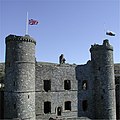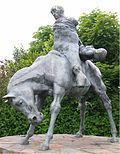Harlech
| Harlech | |
| Merionethshire | |
|---|---|
 Harlech Castle | |
| Location | |
| Grid reference: | SH581312 |
| Location: | 52°51’38"N, 4°6’20"W |
| Data | |
| Population: | 1,952 (2001) |
| Post town: | Harlech |
| Postcode: | LL46 |
| Dialling code: | 01766 |
| Local Government | |
| Council: | Gwynedd |
| Parliamentary constituency: |
Dwyfor Meirionnydd |
Harlech is a town and seaside resort in Merionethshire. It stands on the cliff towering over Tremadog Bay. The town is best known for Harlech Castle, which dominates the little town.
The castle was originally built next to the sea, but geological processes have changed the shape of the coastline, and the castle now lies on a cliff face, about half a mile inland. The historic heart of the town is the high town by the castle. Here are the narrow shopping street, church, and castle. Houses have since grown up the hillside and since the accretional of land beneath, the town has developed housing on the flat low town. The high town and low town are linked by a steep and winding road called "Twtil."
The town is on the railway, on the Cambrian Coast Line. It has a population of 1,952, of whom 59% speak Welsh. It falls within the Snowdonia National Park.
Harlech Castle
The Castle was begun in 1283 by King Edward I of England; part of his Iron Ring around Snowdonia. It was built on the sea cliff, whence it could be supplied by sea in case of siege as indeed it was when besieged by Madoc ap Llywelyn, son of the last Lord of Merioneth, and in the famous 7-year siege, though the sea has since retreated.
From 1404 to 1408, the castle was taken and held by Owain Glyndŵr during his rebellion against the new House of Lancaster: Monmouth-born Prince Henry, later Henry V, took the castle back. In the 1460s as England and Wales were racked by the Wars of the Roses, Harlech Castle was held for King Edward IV (of the House of Lancaster). Between 1461 and 1468, Harlech, under its redoubtable Constable, Dafydd ap Ieuan, endured a seven years siege by the Yorkists. In 1468, Harlech was the last Lancastrian fortress to surrender.
During the days of Queen Elizabeth I, the castle had fallen into disrepair, and the Queen was asked to order that the justices of Merionethshire meet in Harlech Castle rather than in Bala, in order to ensure that the castle would be kept in repair at local expense and not at Crown expense, but no action was taken. During the Civil War, Harlech held out for the King and suffered heavy bombardment from the forces of Parliament, which scars it bears still. Harlech then was the last Royalist stronghold to surrender; holding out until 16 March 1647, over a year after King Charles had himself been captured.
Harlech in popular culture
- The song Men of Harlech is associated with the town, and is traditionally said to describe events during the seven year long siege of the castle between 1461 and 1468.[1]
- Mari Strachan's 2009 novel The Earth Hums in B Flat (2009) is set in Harlech in the 1950s.[2]
Harlech in mythology
Harlech plays a role in the second branch of the Mabinogi, the fine book of mediæval Welsh mythology. In the tale of "Branwen, Daughter of Llŷr," Harlech is the seat of Bendigeidfran, Branwen's brother and king of the "Isle of the Mighty." Towards the ending of the tale, the seven survivors of the war between the Irish and the Welsh are requested by the wounded Bendigeidfran to have his head cut off and carried to Gwynfryn in London.
As instructed the seven men first return to Harlech and feast for seven years, entertained by the three birds of Rhiannon, and later spend another eighty years at Gwales. The otherworldly feasting at Harlech and Gwales, with boundless supply of food and drink, heavenly music, and the absence of grief and sorrow, is known in the early Welsh tradition as "The Assembly of the Noble Head."[3]
Recreation
Theatr Harlech (formerly called Theatr Ardudwy) is located on the Coleg Harlech campus and stages a varied selection of plays, music, and films throughout the year.
Other attractions in Harlech include its beach backed with sand dunes and the famous Royal Saint David's Golf Club, a top British course.
The Rhinogydd (or Rhinogs) range of mountains rises to the east.
A Second World War-era fighter aircraft was found on Harlech beach in 2007. The discovery of the Lockheed P-38 Lightning has been described as "one of the most important WWII finds in recent history." The International Group for Historic Aircraft Recovery (TIGHAR) are not divulging the precise location of the US Army Air Forces aeroplane, known as the Maid of Harlech, but are hoping to eventually salvage the wreck.[4]
Picture gallery
-
Harlech Castle with flags at half mast after death of Queen Elizabeth the Queen Mother in 2002
-
Harlech Castle gatehouse
-
The Two Kings by Ivor Robert-Jones: Bendigeidfran carries the body of his nephew Gwern
-
Harlech Beach at low tide.
-
Harlech College with Harlech Castle in background
References
- ↑ The Oxford Companion to British History - Oxford University Press (1997) page 454; Dictionary of Ancient & Mediæval Warfare by Matthew Bennett (2001)
- ↑ "What the blogs say about The Earth Hums in B Flat" at maristrachan.info
- ↑ Ford, Patrick K. The Mabinogi and other Mediæval Welsh Tales. Berkeley: U of California Press, 1977. pp. 57-72.
- ↑ Charity hopes to lift Second World War fighter plane from sea at walesonline.co.uk
Outside links
| ("Wikimedia Commons" has material about Harlech) |
- Harlech Tourism Association
- Theatr Harlech
- Royal Saint David's Golf Club
- Aerial photograph of Harlech
- geograph.co.uk - photos of Harlech and surrounding area




